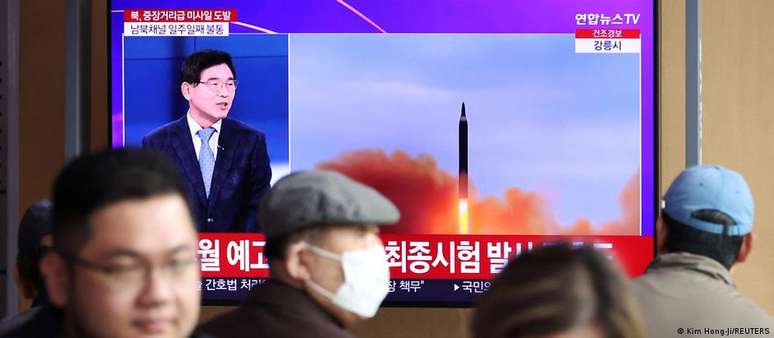The Japanese have been warned to seek protection. South Korea claims that the test would be a “new type” of solid fuel missile, a possible technical breakthrough in Pyongyang’s war program, which fell into the Sea of Japan after traveling about 1,000 kilometers and forced the Japanese authorities to temporarily activate the alert for a possible impact around the island of Hokkaido, in the north of the country.
Approximately 40 minutes after launch, the J-Alert system was activated in Japan, which allows authorities to broadcast civil security alerts simultaneously through telephones, radio, television and loudspeakers located in each municipality.
On the island of Hokkaido, home to more than 5 million people, people have been urged to seek air-raid shelter due to the possibility of the shell hitting the area.
It’s not the first time this has happened. Last November, an ICBM launched from Pyongyang had already triggered an air raid alarm in Japan, prompting the population to seek refuge.
stopped trains
The notice has been issued to all vessels around Hokkaido, and the local railway operator has decided to temporarily suspend the operation of all trains on the island.
However, the warning was deactivated a few minutes later, when the risk of impact had been ruled out, and around 8:19 (local time) the Japanese Coast Guard declared that the projectile had already fallen into the sea. Shortly thereafter, the South Korean JCS system indicated that the missile landed in the Sea of Japan, without overflying Hokkaido as initially feared.
Japanese government spokesman Hirokazu Matsuno defended the “adequate” functioning of the J-Alert system when questioned at a press conference about the contradictory information offered to the population through the platform in a short space of time. He said that “the alert was issued from the point of view of public safety priority”.
temporary panic
Schools in Hokkaido have delayed their opening hours and some train services have been suspended, according to Japanese broadcaster NHK.
One student said the alarm caused momentary alarm at a train station. “For a second there was panic on the train, but a station employee asked for calm and people complied,” a student told NHK.
Existing data suggests that the North Korean projectile may have been flying for about an hour.
New type of missile
The South Korean military said the launch was possibly a “new-type” intercontinental ballistic missile (ICBM), which must have used advanced solid fuel, which would represent a potential technical advance in Pyongyang’s war program. .
All of Pyongyang’s known ICBMs are liquid fueled. And solid-fuel ICBMs that can be launched from land or submarines have long been at the top of North Korean leader Kim Jong-un’s wish list.
These missiles are easier to store and transport, more stable and faster to prepare for launch, and therefore more difficult to preemptively detect and destroy.
At a military parade in Pyongyang in February, North Korea displayed a record number of nuclear and ICBMs, including what analysts said was possibly a new solid-fuel ICBM.
The United States said it “strongly condemned” North Korea for testing what it described as a “long-range ballistic missile”.
release series
The launch is the latest in a series of banned weapons tests conducted by North Korea, which has launched several of its most powerful ICBMs this year.
On March 16, North Korea launched into the Sea of Japan an intercontinental ballistic missile (ICBM) of the Hwasong-17 type, the longest-range potential missile in its arsenal, as well as a Hwasong-15 (the second range) on February 18 , which fell southwest of Hokkaido.
Both shells had very similar flight parameters to the one fired Thursday, staying in the air for just over 60 minutes and covering distances of around 1,000 kilometers from the launch point.
radioactive tsunami
Pyongyang has also tested what state media say are nuclear-capable underwater drones – known as Haeil, the Korean word for tsunami – which are said to be capable of triggering a “radioactive tsunami”.
On Monday, the North Korean leader attended a meeting of the Central Military Commission to discuss ways to “deal with the growing moves by US imperialists and traitorous South Korean puppets to unleash a war of aggression,” media reported Pyongyang state. Kim ordered to strengthen the country’s deterrence capabilities with “increasing speed” and in a “more practical and offensive” way.
strained relationships
Relations between the two Koreas are in one of the most tense moments in recent years, with Pyongyang last year declaring itself an “irreversible” nuclear power and effectively ending the possibility of denuclearization talks.
Earlier this year, Kim ordered the military to step up drills to prepare for a “real war”. In response, Washington and Seoul have stepped up cooperation on defense matters, conducting joint military exercises using US jets and advanced warfare equipment.
North Korea sees these maneuvers as rehearsals for an invasion, and on Tuesday described them as “frantic” exercises simulating “an all-out war against” Pyongyang.
cut contacts
South Korea also accused North Korea of being “irresponsible” on Tuesday after Pyongyang cut direct contacts with Seoul last week.
Since Friday, North Korea has not responded to calls made twice a day via a military hotline and an inter-Korean communication channel, according to the Unification Ministry in Seoul.
Contacts were severed a day after Seoul accused Pyongyang of continuing unauthorized use of a joint industrial complex in the North Korean city of Kaesong.
md/lf (EFE, AFP, Reuters)
Source: Terra
Rose James is a Gossipify movie and series reviewer known for her in-depth analysis and unique perspective on the latest releases. With a background in film studies, she provides engaging and informative reviews, and keeps readers up to date with industry trends and emerging talents.


![Un Si Grand Soleil Preview: Eliot Between Life and Death!… What’s in store for the week of October 20-24, 2025 [SPOILERS] Un Si Grand Soleil Preview: Eliot Between Life and Death!… What’s in store for the week of October 20-24, 2025 [SPOILERS]](https://fr.web.img4.acsta.net/img/f1/c4/f1c410b63f2bfb1cd2353db8bf7e9d58.jpg)



